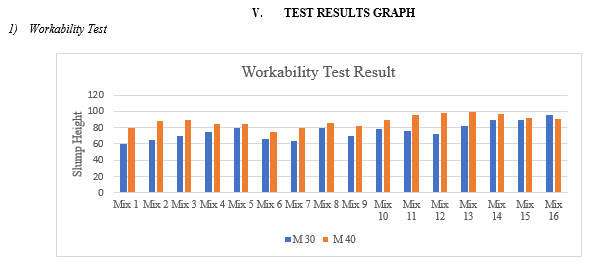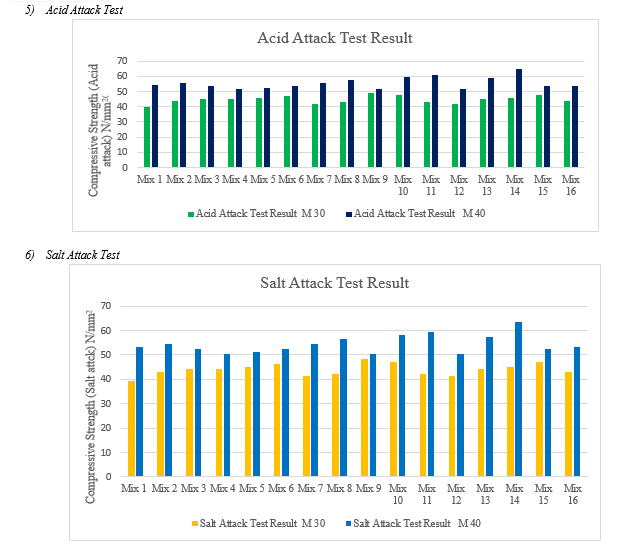Ijraset Journal For Research in Applied Science and Engineering Technology
- Home / Ijraset
- On This Page
- Abstract
- Introduction
- Conclusion
- References
- Copyright
Experimental Study on Workability, Strength & Durability of Geopolymer Concrete with use of Fly ash, Ground Granulated Blast Furnace Slag & Silica Fume
Authors: Jeet Vagadiya, Prof. Kishan Vekariya
DOI Link: https://doi.org/10.22214/ijraset.2024.61453
Certificate: View Certificate
Abstract
Geopolymer concrete, crafted from a blend of Fly Ash, GGBS, and Silica Fume activated by sodium silicate and sodium hydroxide, demonstrates excellent workability and strength over time. It proves resilient against acid, chloride, water absorption, and carbonation, making it a sustainable choice for construction projects seeking durability and performance. These qualities position geopolymer concrete as a promising alternative to traditional concrete methods.
Introduction
I. INTRODUCTION
The construction industry's reliance on ordinary Portland cement (OPC) contributes significantly to global carbon dioxide (CO2) emissions, prompting a search for more sustainable alternatives. Geopolymer, derived from alkaline solutions reacting with aluminosilicate-rich waste materials, presents a promising solution.
Unlike OPC, geopolymerization occurs at room temperature, reducing energy consumption and emissions. Geopolymer concrete exhibits superior strength and durability, with the potential to reduce CO2 emissions by 10-30% compared to OPC. This innovative material offers benefits such as efficient waste management and enhanced concrete performance, positioning it to revolutionize construction practices toward a more sustainable future
II. . NEED OF STUDY
To investigate the feasibility and effectiveness of using a combination of fly ash, ground granulated blast furnace slag (GGBS), and silica fume as the sole binder in geopolymer concrete, focusing on its workability, strength, and durability.
III. OBJECTIVE OF STUDY
- To determine the optimal proportions of fly ash, GGBS, and silica fume in the geopolymer concrete mix to achieve desired workability without the use of traditional cement.
- To evaluate the compressive strength, splitting tensile strength, and flexural strength of geopolymer concrete at different curing ages.
- To assess the durability of geopolymer concrete by evaluating its resistance to water absorption, chloride ion penetration, and sulfate attack.
- To compare the environmental impact of geopolymer concrete with Portland cement concrete in terms of CO2 emissions and energy consumption, focusing on the reduced carbon footprint by eliminating traditional cement.
- To develop a cost-effective and sustainable mix design for geopolymer concrete utilizing only industrial by-products as the binder
IV. PROPOSED MIX PROPORTION
- The given value is shown in Percentage (%)
|
Mix No. |
GGBS |
Fly Ash |
Silica Fume |
|
1 |
100 |
0 |
0 |
|
2 |
90 |
10 |
0 |
|
3 |
80 |
20 |
0 |
|
4 |
70 |
30 |
0 |
|
5 |
60 |
40 |
0 |
|
6 |
50 |
50 |
0 |
|
7 |
85 |
10 |
5 |
|
8 |
75 |
20 |
5 |
|
9 |
65 |
30 |
5 |
|
10 |
55 |
40 |
5 |
|
11 |
45 |
50 |
5 |
|
12 |
80 |
10 |
10 |
|
13 |
70 |
20 |
10 |
|
14 |
60 |
30 |
10 |
|
15 |
50 |
40 |
10 |
|
16 |
40 |
50 |
10 |
2. The given value of Mix Proportion of M30 Geopolymer Concrete by Weight
|
Mix No. |
GGBS |
FLYASH |
SILICA FUME |
Sodium Hydroxide |
Sodium Silicate |
Coarse Aggregate |
Fine Aggregate |
Water |
Super Plasticizer |
|
1 |
438.13 |
- |
- |
50.072 |
125.18 |
983.77 |
556.76 |
104.93 |
4.38 |
|
2 |
394.32 |
43.81 |
- |
50.072 |
125.18 |
975.44 |
552.04 |
104.93 |
4.38 |
|
3 |
350.51 |
87.63 |
- |
50.072 |
125.18 |
967.11 |
547.33 |
104.93 |
4.38 |
|
4 |
306.69 |
131.44 |
- |
50.072 |
125.18 |
958.78 |
542.62 |
104.93 |
4.38 |
|
5 |
262.88 |
175.25 |
- |
50.072 |
125.18 |
950.45 |
537.9 |
104.93 |
4.38 |
|
6 |
219.07 |
219.07 |
- |
50.072 |
125.18 |
942.12 |
533.19 |
104.93 |
4.38 |
|
7 |
372.41 |
43.81 |
21.91 |
50.072 |
125.18 |
971.27 |
549.69 |
104.93 |
4.38 |
|
8 |
328.6 |
87.63 |
21.91 |
50.072 |
125.18 |
962.95 |
544.97 |
104.93 |
4.38 |
|
9 |
284.79 |
131.44 |
21.91 |
50.072 |
125.18 |
954.62 |
540.26 |
104.93 |
4.38 |
|
10 |
240.97 |
175.25 |
21.91 |
50.072 |
125.18 |
946.29 |
535.55 |
104.93 |
4.38 |
|
11 |
197.16 |
219.07 |
21.91 |
50.072 |
125.18 |
937.96 |
530.83 |
104.93 |
4.38 |
|
12 |
350.51 |
43.81 |
43.81 |
50.072 |
125.18 |
967.11 |
547.33 |
104.93 |
4.38 |
|
13 |
306.69 |
87.63 |
43.81 |
50.072 |
125.18 |
958.78 |
542.62 |
104.93 |
4.38 |
|
14 |
262.88 |
131.44 |
43.81 |
50.072 |
125.18 |
950.45 |
537.9 |
104.93 |
4.38 |
|
15 |
219.07 |
175.25 |
43.81 |
50.072 |
125.18 |
942.12 |
533.19 |
104.93 |
4.38 |
|
16 |
175.25 |
219.07 |
43.81 |
50.072 |
125.18 |
933.8 |
528.8 |
104.93 |
4.38 |
3. The given value of Mix Proportion of M40 Geopolymer Concrete by Weight
|
Mix No. |
GGBS |
FLYASH |
SILICA FUME |
Sodium Hydroxide |
Sodium Silicate |
Coarse Aggregate |
Fine Aggregate |
Water |
Super Plasticizer |
|
1 |
518.84 |
* |
* |
59.29 |
148.24 |
680.35 |
739.3 |
87.94 |
5.19 |
|
2 |
466.96 |
51.88 |
* |
59.29 |
148.24 |
672.99 |
731.31 |
87.94 |
5.19 |
|
3 |
415.07 |
103.77 |
* |
59.29 |
148.24 |
665.63 |
723.31 |
87.94 |
5.19 |
|
4 |
363.19 |
155.65 |
* |
59.29 |
148.24 |
658.27 |
715.32 |
87.94 |
5.19 |
|
5 |
311.32 |
207.54 |
* |
59.29 |
148.24 |
650.92 |
707.32 |
87.94 |
5.19 |
|
6 |
259.42 |
259.42 |
* |
59.29 |
148.24 |
643.56 |
699.33 |
87.94 |
5.19 |
|
7 |
441.02 |
51.88 |
25.94 |
59.29 |
148.24 |
669.31 |
727.31 |
87.94 |
5.19 |
|
8 |
389.13 |
103.77 |
25.94 |
59.29 |
148.24 |
661.95 |
719.31 |
87.94 |
5.19 |
|
9 |
337.25 |
155.65 |
25.94 |
59.29 |
148.24 |
654.6 |
711.33 |
87.94 |
5.19 |
|
10 |
285.36 |
207.54 |
25.94 |
59.29 |
148.24 |
647.24 |
703.32 |
87.94 |
5.19 |
|
11 |
233.48 |
259.42 |
25.94 |
59.29 |
148.24 |
639.88 |
695.33 |
87.94 |
5.19 |
|
12 |
415.07 |
51.88 |
51.88 |
59.29 |
148.24 |
665.63 |
723.31 |
87.94 |
5.19 |
|
13 |
363.19 |
103.77 |
51.88 |
59.29 |
148.24 |
658.27 |
715.32 |
87.94 |
5.19 |
|
14 |
311.31 |
155.65 |
51.88 |
59.29 |
148.24 |
650.92 |
707.32 |
87.94 |
5.19 |
|
15 |
259.42 |
207.54 |
51.88 |
59.29 |
148.24 |
643.56 |
699.33 |
87.94 |
5.19 |
|
16 |
207.54 |
259.42 |
51.88 |
59.29 |
148.24 |
636.2 |
691.33 |
87.94 |
5.19 |



Conclusion
In summary, the use of GGBS activated with neutral water glass effectively regulates setting times in slag-based geopolymer concrete, while incorporating fly ash and GGBS with sodium silicate enhances workability. Higher GGBS percentages decrease setting time and workability but increase compressive strength. Geopolymer concrete typically shows higher density than OPC, with formulations high in fly ash content capable of curing in ambient conditions. Regarding comparisons with OPC, GPC exhibits lower modulus of elasticity but higher deformation capacity and ductility at equivalent strengths. Optimizing GPC performance involves specific ratios of NaOH, Na2SiO3, and total alkali activator to fly ash. Geopolymer technology offers a sustainable alternative to OPC, utilizing fly ash to reduce CO2 emissions. Recent advancements highlight the potential for enhancing compressive strength, especially in cast-in-situ applications. Further research is needed to explore long-term durability and structural applications, but experimental studies demonstrate promising mechanical properties and offer insights into mix design optimization for sustainable construction with geopolymer concrete.
References
[1] N. D. Shaikh, N. D. Shah, and F. Ash, “Materials Today?: Proceedings Advancements in self-compacting geopolymer concrete?: A comprehensive overview,” Mater. Today Proc., no. October, 2023, doi: 10.1016/j.matpr.2023.10.004. [2] C. R. Meesala, “Critical review on fly-ash based geopolymer concrete,” no. August, pp. 1–16, 2019, doi: 10.1002/suco.201900326. [3] R. Amar, R. Devanand, H. N. Harsha, and K. C. Sachin, “Materials Today?: Proceedings Experimental studies on GGBS based geopolymer concrete,” Mater. Today Proc., no. xxxx, 2023, doi: 10.1016/j.matpr.2023.04.297. [4] P. G. Sawarkar, A. Pote, and A. Lal, “Materials Today?: Proceedings Properties of blast furnace slag geopolymer concrete,” Mater. Today Proc., no. xxxx, 2024, doi: 10.1016/j.matpr.2023.03.179. [5] N. A. Eren, R. Alzeebaree, and M. E. Gu, “Fresh and hardened state performance of self-compacting slag based alkali activated concrete using nanosilica and steel fiber,” 2021, doi: 10.1177/00219983211032390. [6] S. Vediyappan, P. Kandukalpatti, and B. Bhajantri, “An Experimental Investigation on Geopolymer Concrete Utilising Micronized Biomass Silica and GGBS,” vol. 25, pp. 2134–2142, 2021, doi: 10.1007/s12205-021-1477-8. [7] A. Sener and M. C. Acar, “Effect of activators in different ratios on compressive strength of geopolymer concrete,” vol. 79, pp. 69–79, 2023. [8] S. D. Kurhade and S. V Patankar, “Materials Today?: Proceedings Effect of water-to-binder ( W / B ) ratio and various zones of river sand on properties of geopolymer concrete,” Mater. Today Proc., no. xxxx, 2023, doi: 10.1016/j.matpr.2023.07.162. [9] N. Subash and S. A. Kumar, “A simplified geopolymer concrete mix design considering five mineral admixtures,” Eur. J. Environ. Civ. Eng., vol. 26, no. 15, pp. 7572–7585, 2022, doi: 10.1080/19648189.2021.2003252. [10] D. Upadhyay, A. Chanda, and S. Thakkar, “Materials Today?: Proceedings Mixture Design of High-Strength Geopolymer Concrete,” Mater. Today Proc., no. April, 2023, doi: 10.1016/j.matpr.2023.07.265. [11] P. Sukontasukkul, P. Chindaprasirt, P. Pongsopha, T. Phoo-ngernkham, W. Tangchirapat, and N. Banthia, “Effect of fly ash / silica fume ratio and curing condition on mechanical properties of fiber- reinforced geopolymer,” J. Sustain. Cem. Mater., vol. 0, no. 0, pp. 1–15, 2020, doi: 10.1080/21650373.2019.1709999. [12] G. M. Rao and T. D. G. Rao, “Final Setting Time and Compressive Strength of Fly Ash and GGBS-Based Geopolymer Paste and Mortar,” pp. 3067–3074, 2015, doi: 10.1007/s13369-015-1757-z. [13] G. Vikas and T. D. G. Rao, “Setting Time , Workability and Strength Properties of Alkali Activated Fly Ash and Slag Based Geopolymer Concrete Activated with High Silica Modulus Water Glass,” Iran. J. Sci. Technol. Trans. Civ. Eng., no. 0123456789, 2021, doi: 10.1007/s40996-021-00598-8. [14] Y. Li, L. Huang, C. Gao, Z. Mao, and M. Qin, “Workability and mechanical properties of GGBS-RFBP-FA ternary composite geopolymer concrete with recycled aggregates containing rec ycled fireclay brick aggregates,” Constr. Build. Mater., vol. 392, no. May, p. 131450, 2023, doi: 10.1016/j.conbuildmat.2023.131450. [15] IS 456: 2000, “Indian Standard Code of Practice for Plain and Reinforced Concrete”, Bureau of Indian Standard, New Delhi [16] IS 383: 1970, “Specification for Coarse aggregate and Fine aggregate from Natural Sources for Concrete”, Bureau of Indian Standard, New Delhi [17] IS 9103: 1999, “Indian Standard Concrete Admixture Specification”, Bureau of Indian Standard, New Delhi [18] IS 10262: 2019, “Recommended Guidelines for Concrete Mix design”, Bureau of Indian Standard, New Delhi [19] IS: 2386-1963 (Part-III). Methods of Test for aggregates for concrete Part III specific gravity, density, voids, absorption and bulking. Bureau of Indian Standards
Copyright
Copyright © 2024 Jeet Vagadiya, Prof. Kishan Vekariya. This is an open access article distributed under the Creative Commons Attribution License, which permits unrestricted use, distribution, and reproduction in any medium, provided the original work is properly cited.

Download Paper
Paper Id : IJRASET61453
Publish Date : 2024-05-01
ISSN : 2321-9653
Publisher Name : IJRASET
DOI Link : Click Here
 Submit Paper Online
Submit Paper Online

